




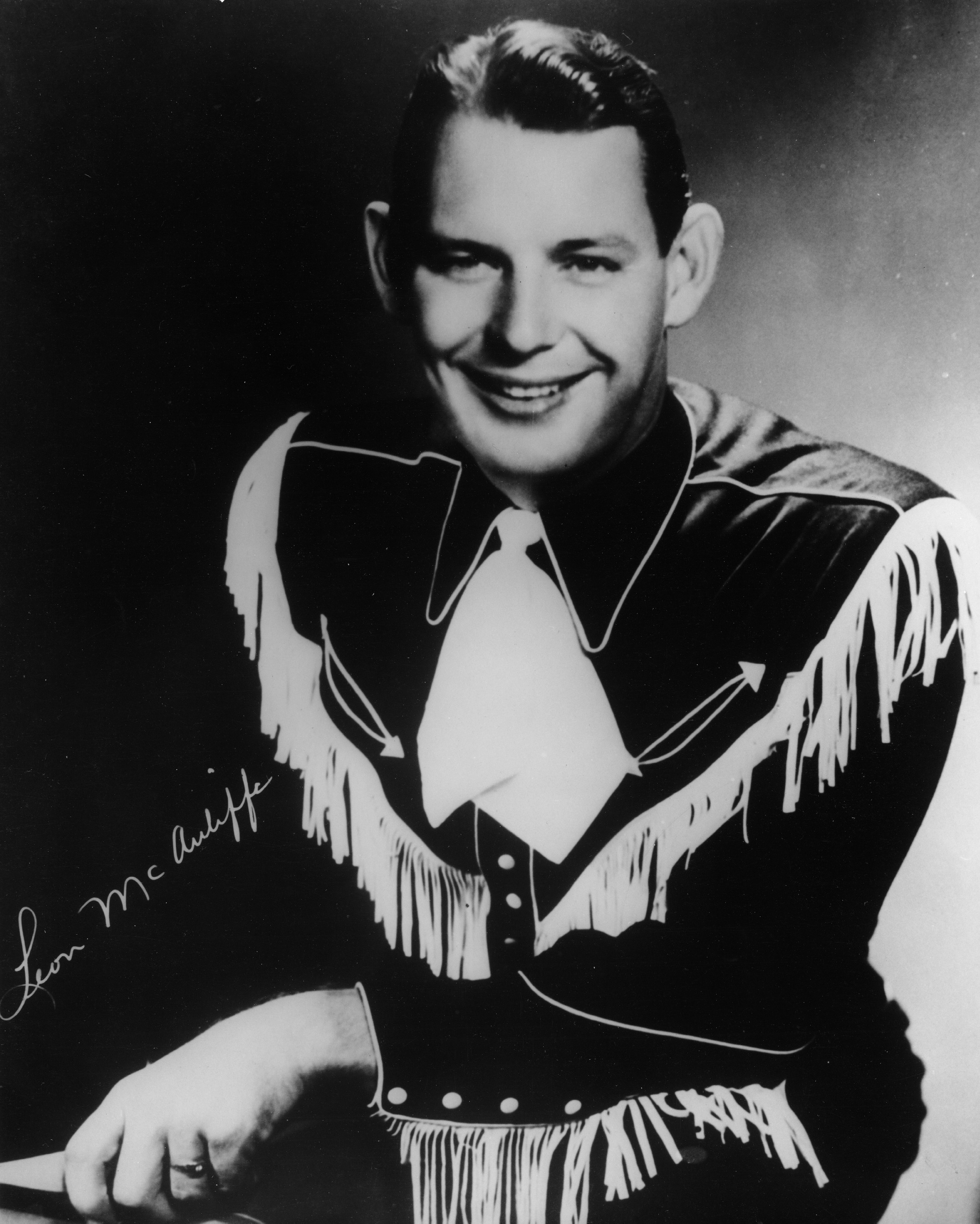





















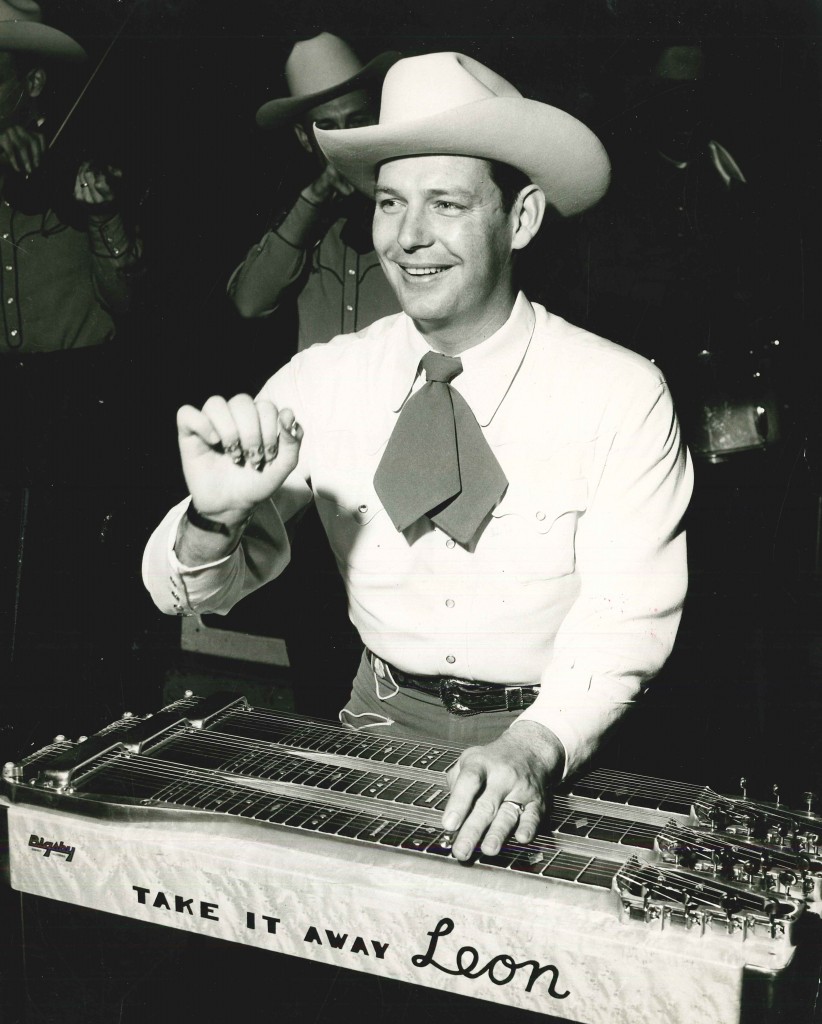

/https://d1pk12b7bb81je.cloudfront.net/images/photos/1470323847-img3187.jpg)










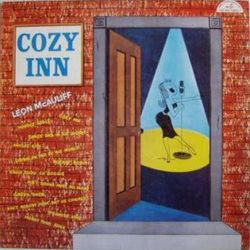

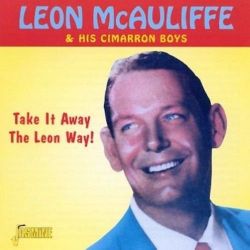
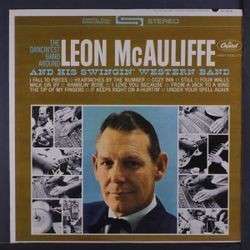

Leon McAuliffe Edition
Leon McAuliffe

Born: 01-03-1917
Died: 08-20-1988
While Leon McAuliffe’s name isn’t a household word these days, for a time, it was a catchphrase etched into popular American culture. Whether you realize it or not, you’ve heard the indelible mark left behind by this guru of the steel guitar, not only in country but also rhythm and blues music.
Born in Harris County, Texas on January 3, 1917, William Leon McAuliffe began playing both regular and resonator type (also known as dobro or steel) guitar at the tender age of 14. Within a year, the young musician was playing on a local Houston radio station with the Waikiki Strummers. This was 1931, when radio performances were recorded live, with musicians huddled around a single microphone, shuffling in and out for solos. Unamplified and unwieldy, the resonator simply couldn’t compete with the horn sections of the popular country swing bands of the time, which were often led by a charismatic fiddle player. Instead, resonator guitar was relegated almost exclusively to quieter Hawaiian music trios.
Young Leon cut his teeth playing this popular music style with a trio comprised of ukulele, acoustic and resonator guitar. Within two years, 16 year-old Leon was tapped to join W. Lee O’Daniel’s Lightcrust Doughboys over the Dallas airwaves. The unusual request gave him pause. “I had no idea of playing country music or fiddle music, you know,” McAuliffe told an audio archivist for Baylor University in 1985, “So I was quite surprised when I got the call and I went up there and had to find a slot to get in to and stay out of people’s way, you know?”
Not only was “Steel Guitar Rag” a smash hit for Bob Wills and the Texas Playboys, but Bob’s admonition to, “Take it away, Leon” caught fire, resonating with an audience that was beaten down by soup lines, drought, dust storms and the Great Depression.
Over the next two years, McAuliffe experimented with different ways to incorporate his resonator guitar and Hawaiian riffs into the country swing sound, playing around with background harmonics, exploring new sonic landscapes and even getting the occasional solo. Everything changed for Leon and other steel players in the mid-1930s when Leo Fender (of Fender guitar fame) patented the electric steel guitar. The longer sustain and greater volume control of the plugged-in steel guitar effectively switched the instrument’s status from backing rhythm to lead instrument. Suddenly, all the harmonic work Leon had been perfecting fell into place, moving him and his steel front and center in the band.
In 1935, Bob Wills called up the young musician to join his Texas Playboys, one of the biggest bands in western swing. Of course he accepted, bringing along several of his original compositions including “Steel Guitar Rag,” which became a breakout song for the band. Incidentally, it was during this recording session that Bob Wills coined the catchphrase that came to define McAuliffe’s career.
On that fateful day in 1936, “’I’m going to do something different on this,” he (Wills) said, “You hit a chord and I’m going to say something and then you start playing.’ So, I just did a slide into an E chord up there,” Leon recalled, “And he said, ‘Look out friends. Here’s Leon. Take it away my boy, take it away!’”
Not only was “Steel Guitar Rag” a smash hit for Bob Wills and the Texas Playboys, but Bob’s admonition to, “Take it away, Leon” caught fire, resonating with an audience that was beaten down by soup lines, drought, dust storms and the Great Depression. After hearing the song, people started saying, “Take it away, Leon” to each other after handing something off, repeating the catchphrase as a sort of hopeful mantra. Great Depression or not, in this pre-television era, nearly everyone had a radio and at noon tuned in and had lunch with Bob and the boys. “So there were many hardships,” McAuliffe recalled, “But we took entertainment to them every day. And we gave them something to hang on to, see? During the noon hour, they had lunch with us every day. And we had so much fun and we’d dedicate songs to them. We’d do all of these things that made them a part of us.”
At the dawn of WWII, Bob put the band on hiatus. Like so many others of his generation, Leon answered his country’s call serving as an instructor for the US Army Air Corps from 1942 through the end of the war. After the war, he returned to Tulsa and formed a band of his very own, the Western Swing Band. In 1949, Leon released the band’s biggest record, Panhandle Rag, to critical and popular success, with the album reaching number six on the charts.
"I don’t believe anybody in the world could ask for more blessings than we’ve had,” Leon said, “We’ve been the most fortunate people in the world to have grown up at a time when we got a very advanced education and experience of having worked with Bob
By 1950, things were going so well that McAuliffe rented out the second floor of the freshly remodeled Cimarron Ballroom (originally the beautifully ornate Akdar Shrine Mosque) in downtown Tulsa. For the next decade, Leon and his band, now known as the Cimarron Boys, moved in and held court in the ballroom. During this time, they created their own record label (Cimarron Records), hosted a daily radio show over the 50k watt powerhouse KVOO, played a live dance every Wednesday and Saturday at the ballroom, and appeared in several early television variety and music shows.
As rock and honky tonk overtook western swing in popularity in the 1960’s, Leon slowed down as well, semi-retiring to mostly local gigs. Along with several other ‘traditional’ music styles, western swing enjoyed a revival in the early 1970’s, especially in and around Austin, Texas. This was due in no small part to the popularity of country-influenced ‘cosmic cowboy’ bands like Commander Cody and His Lost Airmen, Asleep at the Wheel and Willie Nelson. Even though his health was declining, Bob Wills gathered up the remaining Playboys and performed a reunion tour with Merle Haggard in 1973. Sadly, 1975 saw Bob Wills pass away and McAuliffe took over as leader of the Texas Playboys. In 1976, Leon led Bob Wills’ Original Texas Playboys as they played alongside Asleep at the Wheel on the very first episode of the PBS program Austin City Limits.
In that same year, McAuliffe partnered with country music legends Jim Halsey and Hank Thompson to help found the Hank Thompson School of Country Music in Claremore. At this school, McAuliffe not only taught, but helped fund the recording studio and shared office space with none other than legendary guitarist Junior Brown. The school continued until the early 1990s, when it was shuttered and reopened as Rogers State University.
In one of his last interviews in 1985, a reflective McAuliffe looked back on his life with humility and wonder: “I don’t believe anybody in the world could ask for more blessings than we’ve had,” Leon said, “We’ve been the most fortunate people in the world to have grown up at a time when we got a very advanced education and experience of having worked with Bob (Wills)…the things we did and the places we went and the things we experienced. Then, we have lived this long, and we go back and we do the same thing again and still get applauded for what you do, you know. So, all in all, I’ll just say that life has been wonderful, and for me it has.”
After a lengthy illness, Leon “took it away” one last time in 1988. The legend of the steel guitar now lies in an unmarked grave in the heart of his beloved Tulsa.
For his overwhelming influence on music, Leon McAuliffe was posthumously inducted into the Rock and Roll Hall of Fame in 1999 and the Grammy Hall of Fame in 2011.









